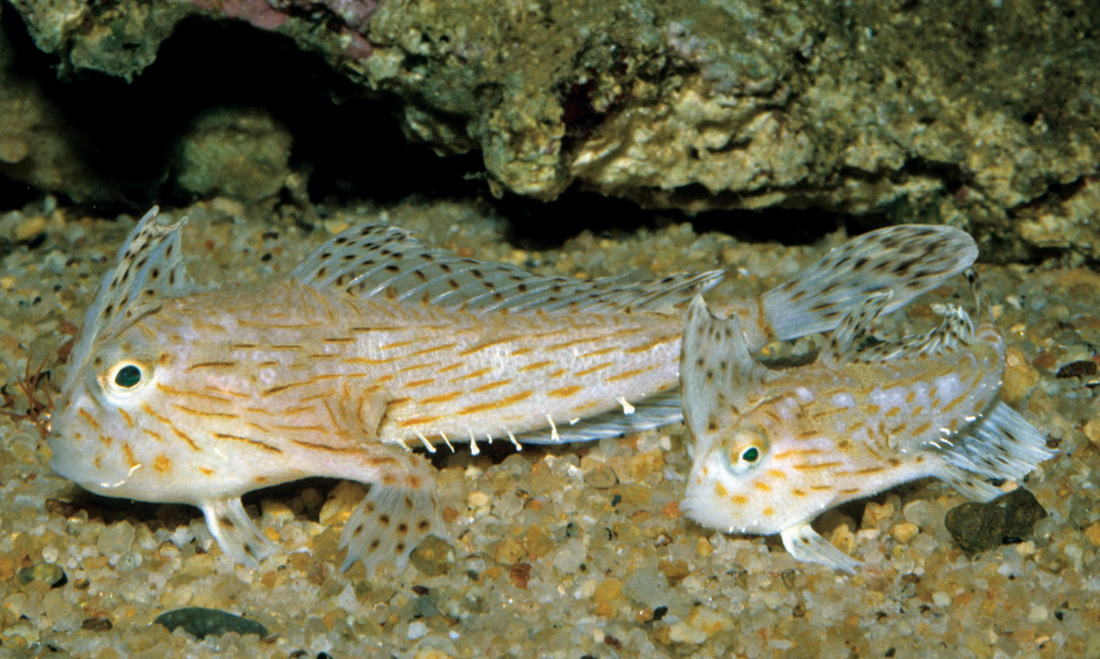Australian Spotted Handfish, Brachionichthys australis Last, Gledhill & Holmes 2007

Brachionichthys australis. Source: Rudie H. Kuiter / Aquatic Photographics. License: All rights reserved
The Australian Spotted Handfish is the most widely distributed species in the family. It differs from the Spotted Handfish, Brachionichthys hirsutus, in having relatively longer dorsal-fin spines but shorter rays, and a different colour pattern.
Australian Spotted Handfish, Brachionichthys australis Last, Gledhill & Holmes 2007
More Info
|
Distribution |
Endemic to eastern and southern Australia, from off North Stradbroke Island, Queensland, to south of Middini Beach in the Great Australian Bight, Western Australia, and off northern and eastern Tasmania south to the D’Entrecasteaux Channel. Bottom dwelling on soft substrates in depths of 18-210 metres, although one individual was trawled bewteen 123 to 277 m (the actual capture depth is unknown). |
|
Features |
Meristic features: Dorsal fin I + II + 17-18; Anal fin 9-10; Caudal fin 9; Pectoral fin 7: Pelvic fin I, 4. Body short, tapering, posterior half noticeably slender, belly rarely enlarged. Head large, depth greater than depth of expanded tail, subtriangular in cross-section; eyes small; mouth small, reaching to below front edge of eye; teeth tiny, narrow band in each jaw; gill opening a tiny tubular pore behind pectoral-fin base. Scales absent, skin covered in spinules; fleshy filaments present on body and upper base of pectoral fin but absent between gill pore and origin of soft dorsal fin. Dorsal fin in three unconnected parts, illicium (first spine), spinous dorsal and soft dorsal; illicium prominent, based on tip of snout, undamaged lure less than 20% of whole structure; spinous dorsal on top of head, tall, anterior margin of first spine serrated; soft dorsal tall, longest ray less than 80% longest dorsal fin spine, lower half of fin generally not covered with skin; anal fin below posterior half of soft dorsal; caudal fin narrow, rounded. Pectoral fin arm-like, tip directed laterally forwards and downwards. Pelvic fins jugular. |
|
Colour |
Pale with narrow yellowish or orange longitudinal lines, occasionally with a few spots; dorsal, caudal and pectoral fins colourless with black or orange spots; pelvic and anal fins mostly colourless or white. |
|
Biology |
Egg diameter 1.7-1.9 mm. |
|
Fisheries |
Taken as bycatch on scallop dredges, and occasionally by trawlers and Danish seiners. |
|
Similar Species |
Differs from the Spotted handfish, Brachionichthys hirsutus, in having a larger eye, a longer 'fishing rod' with a smaller lure at the tip, a longer first dorsal-fin ray, fewer rays in the second dorsal fin and hence a shorter fin base. B. australis is patterned with long thin streaks and stripes (vs small spots or short streaks) and the tail is covered in large dark spots (vs the tail densely covered in fine spots with a dark submarginal band in B. hirsutus). |
|
Etymology |
The specific name is from the latin australis meaning 'southern', in reference to its wide distribution in southern Australia. |
|
Species Citation |
Brachionichthys australis Last, Gledhill & Holmes, 2007, Zootaxa 1666: 55, Figs. 1-2. Type locality: East of Disaster Bay, New South Wales, 37°18'S, 150°17'E, depth 125 metres. |
|
Author |
Dianne J. Bray |
Australian Spotted Handfish, Brachionichthys australis Last, Gledhill & Holmes 2007
References
Hutchins, J.B. & Swainston, R. 1986. Sea Fishes of Southern Australia. Complete field guide for anglers and divers. Perth : Swainston Publishing 180 pp.
Kuiter, R.H. 1993. Coastal Fishes of South-eastern Australia. Bathurst : Crawford House Press 437 pp.
Last, P.R. 1994. Family Brachionichthyidae. pp. 283-285, figs 252-253 in Gomon, M.F., Glover, C.J.M. & Kuiter, R.H. (eds). The Fishes of Australia's South Coast. Adelaide : State Printer 992 pp. 810 figs.
Last, P.R., Gledhill, D.C. & Holmes, B.H. 2007. A new handfish, Brachionichthys australis sp. nov. (Lophiiformes: Brachionichthyidae), with a redescription of the critically endangered spotted handfish, B. hirsutus (Lacepède). Zootaxa 1666: 53-68.
Last, P.R., Scott, E.O.G. & Talbot, F.H. 1983. Fishes of Tasmania. Hobart : Tasmanian Fisheries Development Authority 563 pp. figs.
Last, P.R. & Gledhill, D.C. 2009. A revision of the Australian handfishes (Lophiiformes: Brachionichthyidae), with descriptions of three new genera and nine new species. Zootaxa 2252: 1-77.
Last, P.R. & Gomon, M.F. 2008. Family Brachionichthyidae: Handfishes. pp. 375-376 in Gomon. M.F., Bray, D.J. & Kuiter, R.H (eds). Fishes of Australia's Southern Coast. Sydney : Reed New Holland 928 pp.


